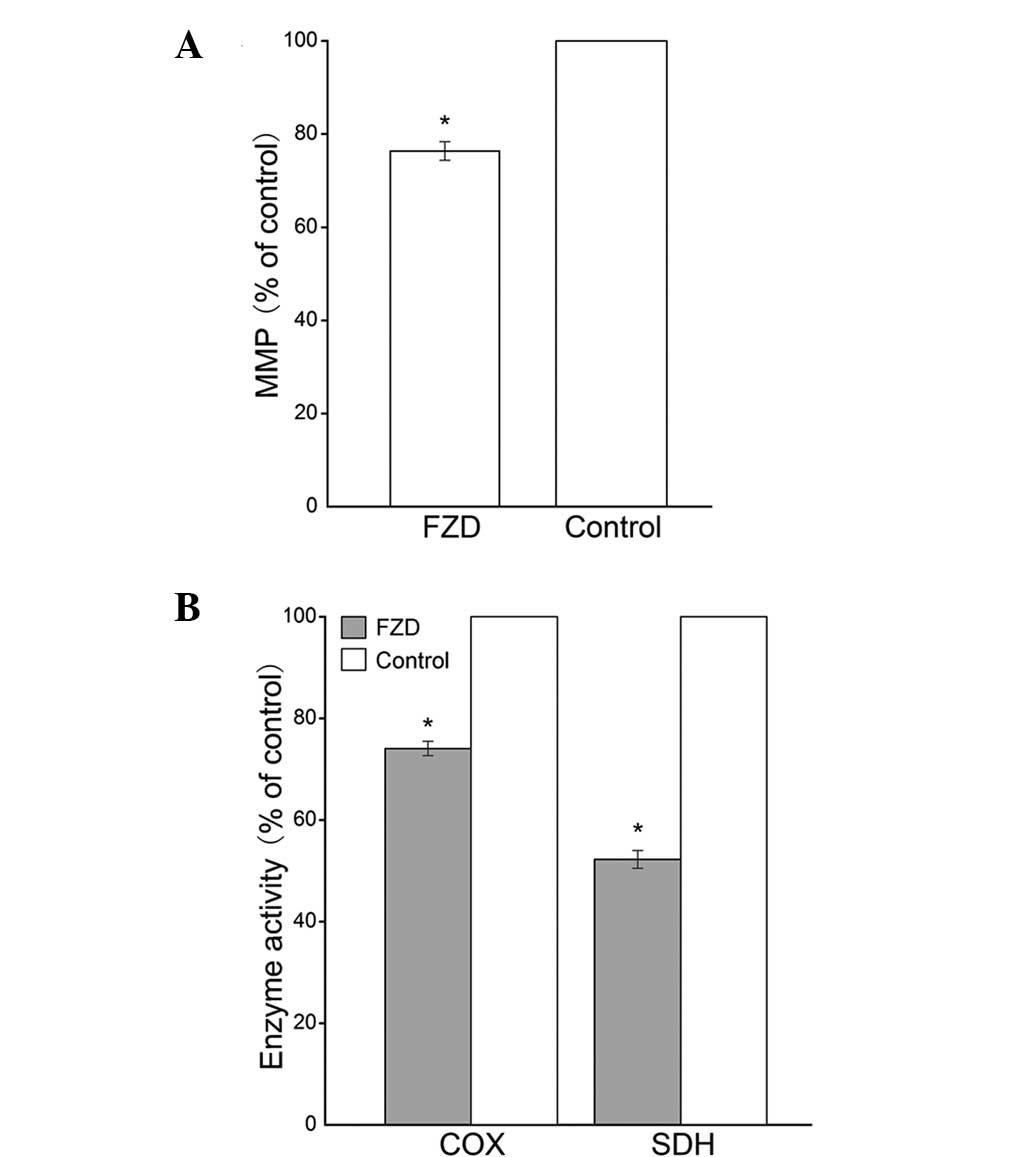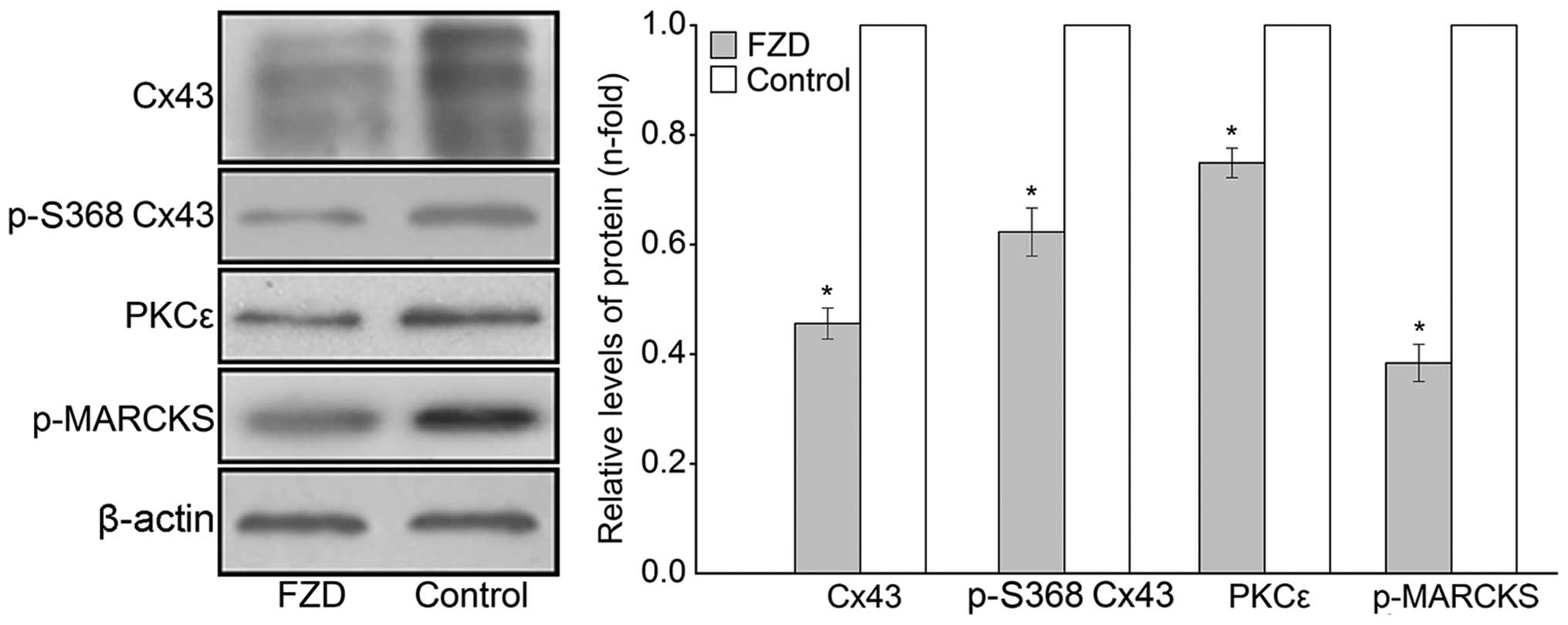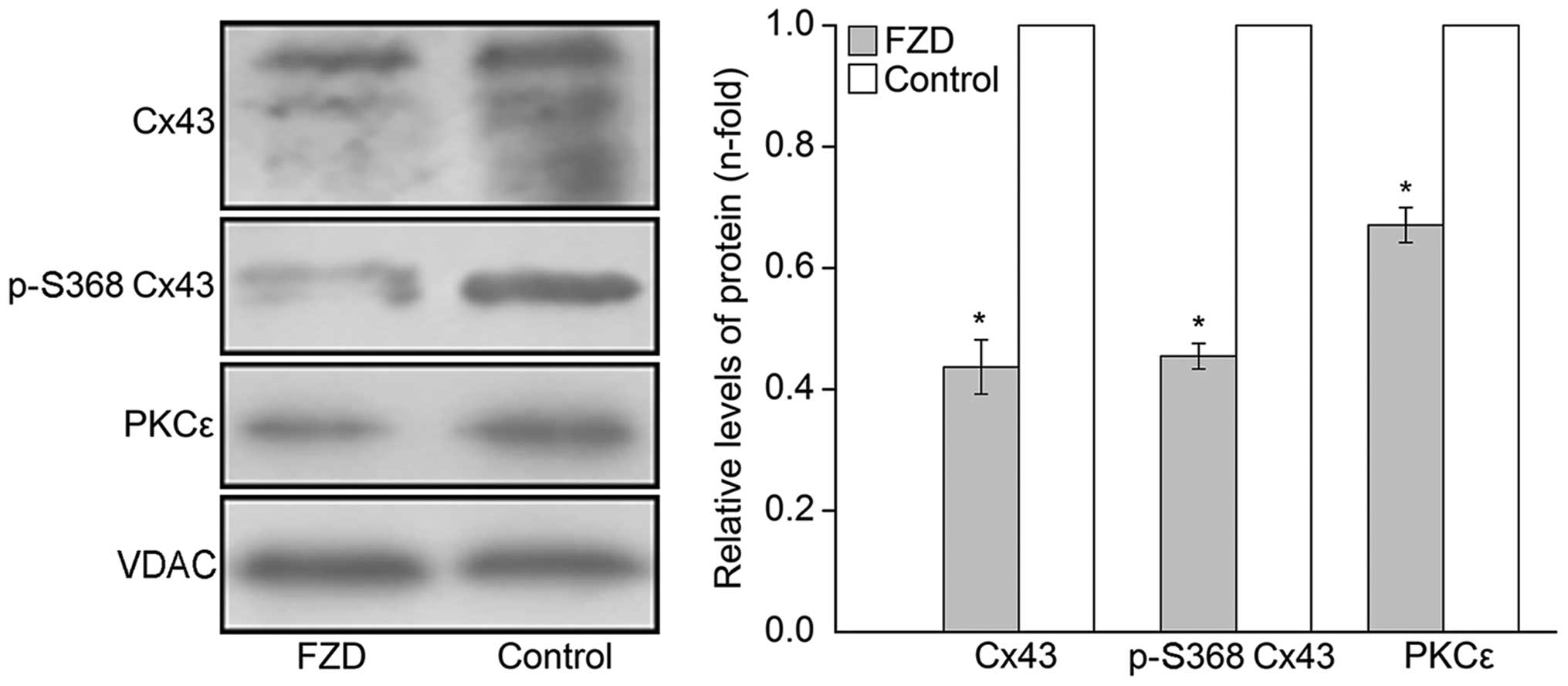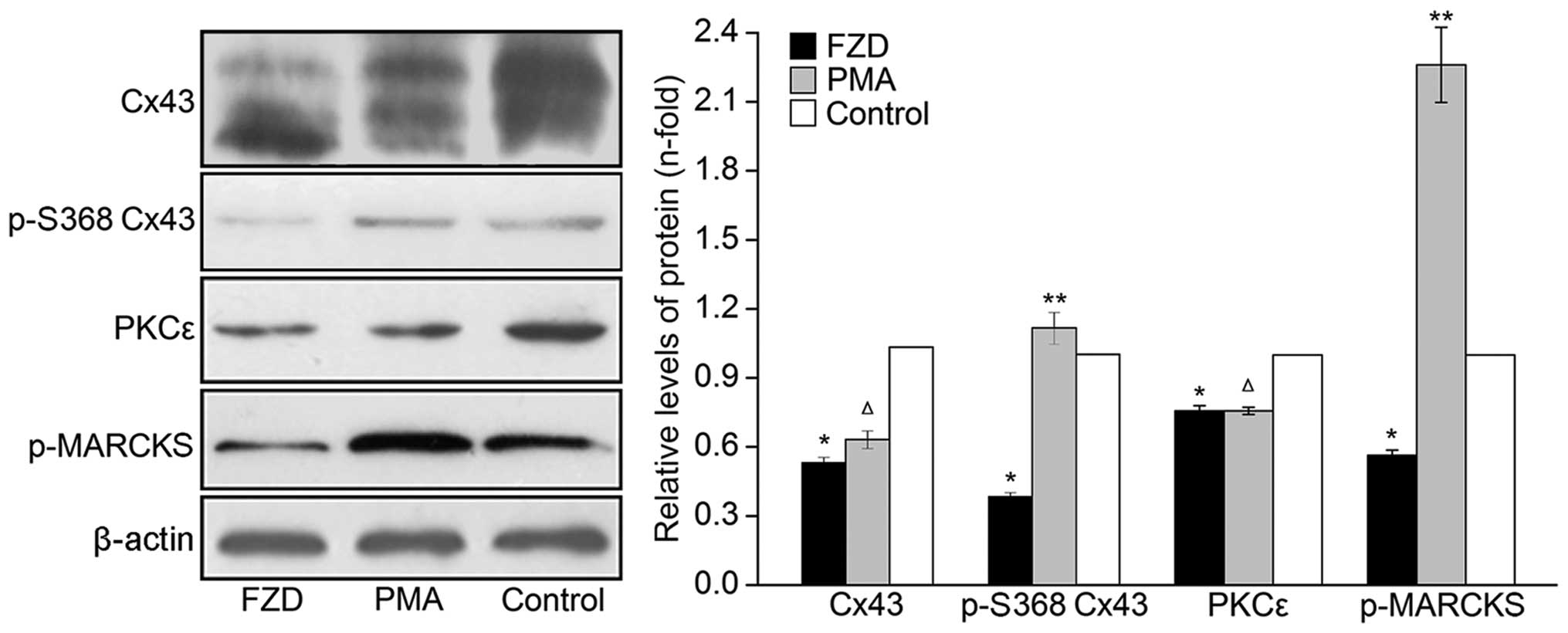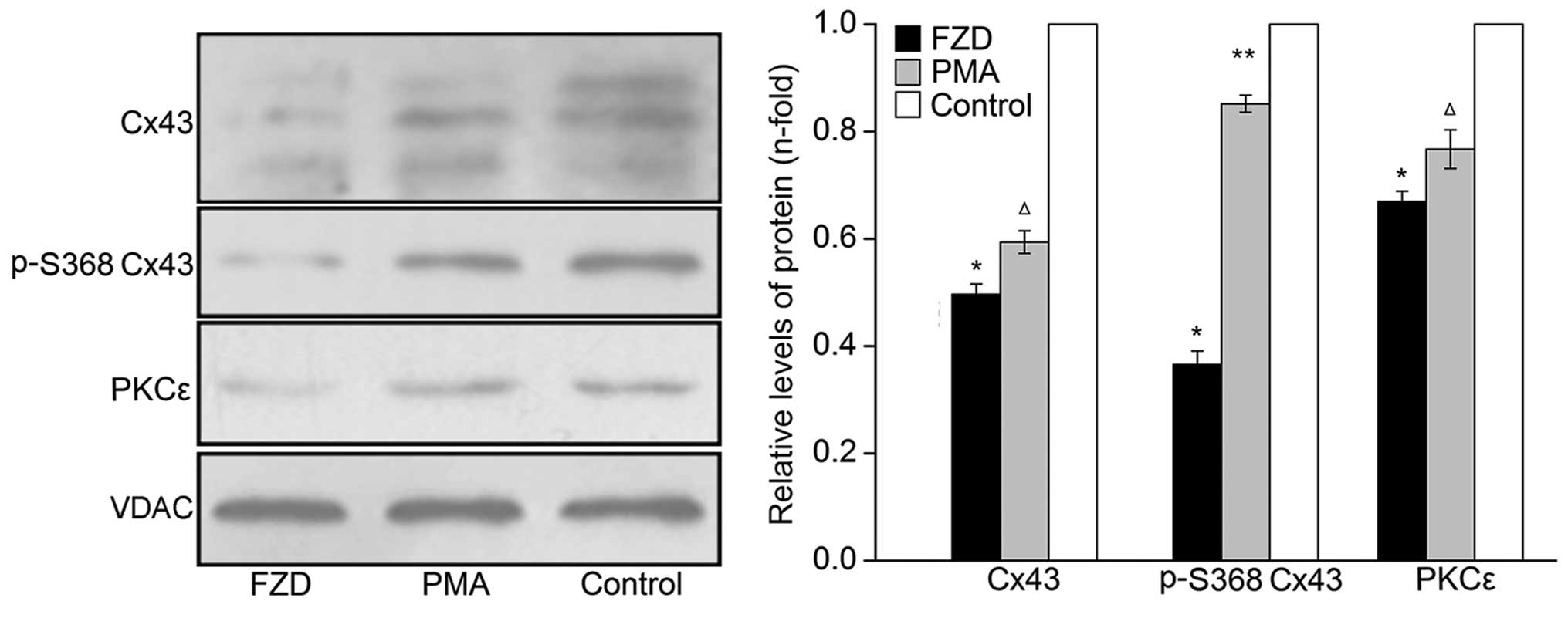Suppression of PKCε-mediated mitochondrial connexin 43 phosphorylation at serine 368 is involved in myocardial mitochondrial dysfunction in a rat model of dilated cardiomyopathy
- Authors:
- Published online on: January 27, 2015 https://doi.org/10.3892/mmr.2015.3260
- Pages: 4720-4726
Abstract
Introduction
Connexin 43 (Cx43) is the predominant connexin in the ventricles is a phosphoprotein, the properties of which are affected by its phosphorylation state (1). Cx43 is primarily located in the sarcolemma of cardiomyocytes, and sarcolemmal Cx43 is important in electrical cell coupling through the formation of a gap junction (1). A previous study demonstrated that Cx43 was also present in the mitochondria of cardiomyocytes, with phosphorylation of >80% of the mitochondrial Cx43 (mtCx43) (2). In addition, a normal mtCx43 content is essential for ischemic preconditioning-induced cardioprotection (3). It has been reported that cardiomyocytes of heterozygous Cx43-deficient mice have a functional deficit in diazoxide-induced cardioprotection (4). By contrast, the mitochondria-specific transgenic overexpression of Cx43 triggers cytoprotection, induced by preconditioning (5). Increasing evidence has indicated that mtCx43 is an important sensor of cardioprotective signals and may be involved in cardiomyocyte pathophysiology. However, whether mtCx43 is involved in the pathogenesis of dilated cardiomyopathy (DCM) and its correlation with mitochondrial dysfunction in cardiomyocytes remain to be fully elucidated.
DCM is the most prevalent type of cardiomyopathy worldwide and mitochondrial dysfunction is reported to be the major mechanism responsible for the development of this disease (6). In order to investigate the mechanism underlying mitochondrial dysfunction in DCM, a rat model of DCM was established in a previous study by daily oral administration of furazolidone (FZD) for 30 weeks. This procedure resulted in apparent mitochondrial dysfunction in the myocardium, accompanied by increasing left ventricle dimensions and reduced systolic and diastolic functions (7).
The aim of the present study was to investigate the role of mtCx43 in mitochondrial dysfunction during the pathogenesis of DCM. Therefore, the present study examined the expression and phosphorylation state of mtCx43 in the FZD-treated rat heart and cardiomyocytes, the role of protein kinase C (PKC)ε in the phosphorylation of mtCx43 in rat cardiomyocytes and the impact of mtCx43 suppression on PKCε activator-induced mitochondrial protection in the FZD-treated cardiomyocytes.
Materials and methods
Animal model
The present study was approved by the Institutional Animal Research and Ethics Committee of Xi’an Jiaotong University School of Medicine (Xi’an, China). A total of 36 Sprague-Dawley rats (3 weeks), weighing between 40 and 60 g, were provided by the Animal Center of Xi’an Jiaotong University School of Medicine and were randomly divided into two groups. The rats were housed individually and provided with ad libitum access to food and water in a temperature-controlled room (22±2°C), under a 12-h light/dark cycle (lights on at 08:00 a.m.). The 24 rats in the FZD group received 700 ppm orally administered FZD solution (Yunpeng Pharmacy Co., Ltd, Shaanxi, China) dissolved in water daily for 30 weeks and the 12 rats in the control group received tap water only. Echocardiographic investigations (iE33; Philips, Amsterdam, Netherlands) were performed in order to identify whether the DCM model was successfully established, as previously described (7).
Cell culture and treatment
Primary culture of neonatal rat cardiomyocytes were prepared and characterized, as previously described (7). The cardiomyocytes were sparsely plated without cell-cell contact and were cultured in Dulbecco’s modified Eagle’s medium (DMEM)/F12 (HyClone Laboratories, Inc., Waltham, MA, USA) containing 10% heat-inactivated fetal bovine serum (FBS; Gibco-BRL, Carlsbad, CA, USA), 100 U/ml penicillin (HyClone; Thermo Fisher Scientific, Waltham, MA, USA) and 100 μg/ml streptomycin sulfate (HyClone) at 37°C with 5% CO2. Prior to treatment, the cells were starved for 24 h in DMEM/F12 medium containing 0.5% FBS. Subsequently, the cells were divided into four groups, as follows: Control group, incubated with vehicle only; FZD group, incubated with 100 μmol/l FZD (Sigma-Aldrich, St. Louis, MO, USA) for 48 h; PMA group, incubated with 100 mmol/l phorbol-12-myristate-13-acetate (PMA; Sigma-Aldrich), a specific PKC activator, for 60 min following 48 h treatment with 100 μmol/l FZD; 18β-glycerrhetinic acid (GA) group, successively treated with 100 μmol/l FZD for 48 h, 50 μmol/l GA (Sigma-Aldrich), a connexin channel inhibitor, for 4 h and 100 nmol/l PMA for 60 min.
Isolation of mitochondria
Mitochondria were isolated from the left ventricles of the rats and the cultured cardiomyocytes through differential centrifugation, as previously described (7). Briefly, the rats were narcotized with 30 mg/kg nembutal (Sigma-Aldrich) and the thorax was opened, in order to excise the heart. The arterial and vessel tissues were removed, and the ventricular tissues were retained and cut into 1 mm sections. The homogenates were centrifuged at 1,000 × g for 10 min and the supernatant was then centrifuged at 10,000 × g for 10 min. Subsequently, the sediment was suspended in isolation buffer (300 mmol/l sucrose, 2 mmol/l HEPES, 0.1 mmol/l EGTA, pH 7.4; Shanghai Genmed Gene Pharmaceutical Technology Co., Ltd., Shanghai, China) and added to the top of 30% percoll solution (Sigma-Aldrich) for centrifugation at 35,000 × g for 30 min. The mitochondrial fraction was collected and washed twice using isolation buffer through centrifugation at 8,000 × g for 5 min.
Mitochondrial membrane potential assay
JC-1 dye (Invitrogen Life Technologies, Carlsbad, CA, USA) was used to assess the mitochondrial membrane potential (MMP) level through the measurement of quantitative fluorescence. The freshly isolated rat myocardial mitochondria or cultured cardiomyocytes were incubated at 37°C for 10 min in DMEM/F12 medium containing 10 μg/ml JC-1. Subsequently, the mitochondria or cardiomyocytes were rinsed twice with phosphate-buffered saline and then scanned in a fluorescence microplate reader (Infinite M200; Tecan Inc., Maennedorf, Switzerland) at 488 nm excitation and 535 nm or 590 nm emission, respectively.
Enzyme activities measurement
The activities of cytochrome c oxidase (COX) and succinate dehydrogenase (SDH) were determined using COX and SDH quantitative colorimetric assay kits (Genemed Co., Ltd, Shanghai and Jiancheng Chemical Industrial Co., Ltd, Nanjing, China, respectively) according to the manufacturer’s instructions. The activity of COX was calculated according to changes in absorbance at 550 nm, measured using a spectrophotometer. The activity of SDH was determined by the speed of the 2,6-dichlorophenol-indophenol reduction reaction (the change in absorbance value at the same time), accompanied by the reduction of flavin adenine dinucleotide (FAD) to FADH.
Reverse transcription quantitative polymerase chain reaction (RT-qPCR)
Total RNA was isolated from the rat left ventricle tissues and cardiomyocytes using TRIzol reagent (Invitrogen Life Technologies) and then 1 μg total RNA was reverse transcribed into cDNA using a cDNA Synthesis kit (Fermentas; Thermo Fisher Scientific), according to the manufacturer’s instructions. The cDNA was amplified using the appropriate primers and the SYBR Premix Ex Taq™ II (Takara Biotechnology Co., Ltd., Dalian, China). qPCR reactions were carried out with an initial denaturation at 95°C for 30 sec, followed by 40 cycles consisting of: Denaturing at 95°C for 5 sec, annealing at 60°C for 30 sec, and extension at 72°C for 30 sec, followed by a melting curve analysis, on an iCycler iQ™ Real Time PCR Detection system (Bio-Rad Laboratories, Inc., Hercules, CA, USA). The primers were as follows: Cx43, forward 5′CATGGGTGACTGGAG-3′ and reverse 5′-AGGACCCAGAAGCGCA-3′; glyceraldahyde-3-phosphate dehydrogenase (GADPH), forward 5′-TTGTGATGGGTGTGAACC-3′ and reverse 5′-TTCTGAGTGGCAGTGATG-3′ (Takara Biotechnology Co., Ltd.). The amount of relative gene expression was calculated by 2-ΔΔCt.
Western blot analysis
The proteins (20 μg) were electrophoresed on 8 or 10% SDS-PAGE (Xi’an Wolsen Bio-technology, Co., Ltd., Xi’an, China) and transferred onto a polyvinylidene difluoride membrane (Millipore, Bedford, MA, USA). The membrane was incubated with 5% non-fat dry milk in Tris-buffered saline solution for 2 h, followed by the addition of the following antibodies: Rabbit polyclonal Cx43 (1:500; cat. no. sc-9059, Santa Cruz Biotechnology, Inc., Dallas, TX, USA), rabbit polyclonal serine 368-phosphorylated Cx43 (p-S368 Cx43; 1:200; cat. no. sc-25165-R, Santa Cruz Biotechnology, Inc.), rabbit monoclonal PKCε (1:1,000; cat. no. 2683, Cell Signaling Technology, Inc., Danvers, MA, USA), rabbit monoclonal p- myristoylated alanine-rich C kinase substrate (p-MARCKS; 1:1,000; cat. no. 11992, Cell Signaling Technology, Inc.), mouse monoclonal voltage-dependent anion channels (VDAC; 1:3,000; cat. no. sc-390996, Santa Cruz Biotechnology, Inc.) or mouse monoclonal β-actin (1:2,000; cat. no. sc-47778, Santa Cruz Biotechnology, Inc.) at 4°C overnight. The membranes were then incubated with peroxidase-conjugated secondary antibodies (1:4,000–1:10,000; cat. nos. sc-2370/1, Santa Cruz Biotechnology) at room temperature for 2 h. The blots were visualized using an enhanced chemiluminescence detection system (Pierce Biotechnology, Inc., Shaanxi, China). β-actin and VDAC were used as loading control for the whole cellular and mitochondrial proteins, respectively.
Statistical analysis
Data from three independent experiments are expressed as the mean ± standard deviation and statistical analyses were performed using SPSS 17.0 software (SPSS, Inc., Chicago, IL, USA). Differences between the groups were evaluated using one-way analysis of variance and a least significant difference test. P<0.05 was considered to indicate a statistically significant difference.
Results
Mitochondrial dysfunction in the myocardium
Freshly isolated mitochondria from the left ventricles were stained with JC-1 to assess the MMP levels. Compared with those in the control group, the MMP levels were significantly decreased in the FZD group (P<0.05; Fig. 1A). In addition, the activities of COX and SDH in the FZD group were significantly reduced (P<0.0; Fig. 1B).
Expression of Cx43 in the myocardium and myocardial mitochondria
RT-qPCR analysis revealed that the mRNA expression of Cx43 in the left ventricle myocardium was markedly downregulated following treatment with FZD compared with that of the untreated control (P<0.05; Fig. 2A). A marked reduction in the mRNA expression levels of Cx43 was also detected in the FZD-treated cardiomyoctes (P<0.05; Fig. 2B). Western blot analysis identified three typical Cx43-specific bands in the myocardial protein extracts. The overall expression of Cx43 in the FZD group was significantly decreased compared with that of the control group (P<0.05; Fig. 3). In addition, the phosphorylation status of Cx43 was analyzed using western blot analysis, which demonstrated that the immunoreactivity of p-S368 Cx43 was reduced by 37.7±4.4% in the myocardium following FZD treatment compared with that of the untreated control (P<0.05; Fig. 3). As shown in Fig. 4, three typical Cx43-specific bands were also detected in the myocardial mitochondrial protein extracts and relatively low levels of overall Cx43 and p-S368 Cx43 were observed in the FZD group compared with those in the control group (P<0.05).
Changes of expression and activity of PKCε in the myocardium and myocardial mitochondria
PKCε is an important cardioprotective mediator, which interacts with Cx43 and is required for the phosphorylation of Cx43 at the S368 PKC target site (8). In the present study, the expression and activity of PKCε were examined using western blot analysis to determine whether PKCε mediated the phosphorylation of Cx43 at S368 in the myocardium and mitochondria. MARCKS is a major substrate of PKCε (9), therefore, p-MARCKS levels were detected in order to assess PKCε activity. The results showed that the immunoreactivity of PKCε in the myocardial protein extracts was reduced by 25.1±2.7% in the FZD group compared with that of the control group (P<0.05;Fig. 3), and the phosphorylation of MARCKS was significantly decreased by 61.6±3.4% (P<0.05;Fig. 3). These changes indicated that FZD induced a marked decrease of PKCε activity in the myocardium. Furthermore, decreased protein expression of PKCε was detected in the myocardial mitochondrial protein extracts following treatment with FZD compared with that of the untreated control (P<0.05; Fig. 4).
Changes of protein expression in FZD-treated cardiomyocytes
In order to investigate the possible mechanism underlying the mitochondrial dysfunction in the FZD-induced DCM rat model, neonatal rat cardiomyocytes were cultured and incubated with 100 μmol/l FZD for 48 h. Western blot analyses revealed that the protein levels of Cx43, p-S368 Cx43 and PKCε significantly decreased in the the whole-cell and mitochondrial protein extracts compared with those of the untreated control (P<0.05; Figs. 5 and 6). Furthermore, the phosphorylation of MARCKS was downregulated by 43.6±2.3% in the cardiomyocytes (P<0.05, Fig. 5).
Effect of PKCε activation on the phosphorylation of Cx43 at serine 368
As shown in Fig. 5, the p-MARCKS immunoreactivity of the PMA group cells was enhanced by 3.00±0.20-fold compared with that of the cells treated with FZD only (P<0.05). In addition, the FZD-induced inhibition of Cx43 phosphorylation at S368 was eliminated by PMA in the cardiomyocytes and mitochondria (P<0.05; Figs. 5 and 6). By contrast, no significant differences were observed in the overall levels of Cx43 in either the cardiomyocyte or mitochondria between the PMA and FZD groups (P>0.05; Figs. 5 and 6).
Role of mtCx43 in regulating mitochondrial function
As shown in Fig. 7, treatment with FZD resulted in a significant decrease in the level of MMP and the activities of COX and SDH compared with those of the control group (P<0.05). Notably, PMA treatment partially reversed the FZD-induced decrease in MMP levels and COX and SDH activities (P<0.05), and pretreatment with GA eradicated the mitochondrial protective effects of PMA (P<0.05).
Discussion
The results of the present study demonstrated that the overall expression levels of mtCx43 and p-S368 mtCx43 were downregulated in the myocardial mitochondria of the DCM rat model as well as the mitochondria of the FZD-treated cardiomyocytes, which was accompanied by suppression of the activity of PKCε and mitochondrial function. In addition, the PKCε activator, PMA, partially reversed FZD-induced mitochondrial dysfunction via a p-S368 mtCx43-dependent mechanism. These data demonstrated a novel mechanism of mitochondrial dysfunction in the DCM rat model, which may involve the PKCε-mediated phosphorylation of Cx43.
Cx43 is the predominant protein forming gap junctions in the myocardium, which are important in intercellular electrical and metabolic coupling (10). A previous study demonstrated that the myocardial expression of Cx43 was significantly downregulated and the phosphorylation of Cx43 was also reduced in patients with non-ischemic cardiomyopathy, and the conduction disorders, which occur due to these abnormalities, may account for arrhythmias in non-ischemic cardiomyopathy (11).
There is increasing evidence for the presence of Cx43 in the inner mitochondrial membrane of cardiomyocytes, where its level may be upregulated by ischemic preconditioning (2). It has been reported that inhibiting heat shock protein 90 only eliminates the upregulation of mtCx43, but also ablates the cardioprotection induced by diazoxide (3). Direct single-channel patch-clamp recordings have revealed that the suppression of myocardial mtCx43 inhibited the function of mitochondrial adenosine triphosphate (ATP)-sensitive K+ channels, which serve as important effectors of cytoprotective signaling (12,13). Accordingly, mtCx43 is important in cardioprotection by ischemic preconditioning via the modulation of mitochondrial ATP-sensitive K+ channels. However, whether the level of mtCx43 was altered and correlated with mitochondrial dysfunction in the pathogenesis of DCM remained to be elucidated. The results of the present study revealed that mtCx43 was significantly downregulated in the DCM rat myocardium, with a reduction in the overall levels of Cx43. Furthermore, the expression of p-S368 mtCx43 was reduced by ~36.8%. In addition, the level of MMP and the activities of COX and SDH were significantly decreased. These findings indicated that the suppression of mtCx43 and/or its phosphorylation may have been associated with mitochondrial dysfunction in the DCM rats.
Cx43 is a phosphoprotein, with several phosphorylation sites targeted by different kinases (14). The phosphorylation of Cx43 at different sites and by different kinases may have different effects. Phosphorylation of Cx43 at serine 279/282 results in impaired cell communication (15), while enhanced dephosphorylation of Cx43 contributes to slow conduction in heart failure via increased activation of p21-activated kinase 1 (16). In addition, the phosphorylation status of Cx43 also affects its suppressive effect on cell proliferation (17). PKCε is essential for the phosphorylation of Cx43 at S368 and is important in ischemic preconditioning-induced cardioprotection by suppressing chemical coupling via Cx43 gap junction modulation (8). Similar to Cx43, PKCε is also located in the mitochondria, which suggests a possible interaction between Cx43 and PKCε in the mitochondria (18). Increasing evidence indicates that the phosphorylation status of Cx43 is not static, but fluctuates in response to cell stress (19–22). In the present study, decreased protein expression of PKCε was observed in the myocardial and mitochondrial protein extracts of the DCM rats, and the PKCε activities also decreased by ~60%. Furthermore, the PKCε activator, PMA, partially reversed the dephosphorylation of Cx43 at S368, indicating that the downregulation of PKCε activity was involved in the FZD-induced dephosphorylation of Cx43.
The results of the present study suggested that the PMA-induced activation of PKCε attenuated mitochondrial dysfunction in the cardiomyocytes. Further investigations demonstrated that inactivation of Cx43 eliminated PMA-induced mitochondrial protection. As the cardiomyocytes were cultured sparsely without cell to cell contact, the targeted inactivation of mtCx43 may have led to the suppression of PMA-induced mitochondrial protection (23,24). These results suggested that activation of PKCε may have attenuated mitochondrial dysfunction in a mtCx43-dependent manner.
In cardiomyocytes, Cx43 is phosphorylated at different sites by various kinases, including mitogen-associated protein kinase (25), protein kinase A (26), protein kinase B (27), casein kinase 1 (28) and the src tyrosine kinase (29). Further studies are required to elucidate whether the phosphorylation states of Cx43, at sites other than S368, alter or are involved in the pathogenesis of DCM. As a regulator of the mitochondrial physiology, cardiac mtCx43 may target mitochondrial adenosine triphosphate-sensitive K+ channels (30). Furthermore, reactive oxygen species formation is reported to be impaired in the cardiomyocytes of Cx43−/− mice (4) and cytochrome c and Ca2+ are induced to release from isolated mitochondria by the Cx43 gap junction inhibitor (31). The present study demonstrated a significant downregulation of p-S368 mtCx43 in the DCM rat myocardium due to the suppression of PKCε activity; however, the precise molecular mechanisms by which mtCx43 affects mitochondrial function require further elucidation.
In conclusion, the present study revealed that the phosphorylation of mtCx43 at S368 was suppressed in the myocardium of DCM rats and was required for the mitochondrial protective effects of the PKCε activator in FZD-treated cardiomyocytes. These findings suggested a possible mechanism involved in mitochondrial dysfunction in the pathogenesis of DCM and revealed a novel mitochondrial protective role of the PKCε activator, PMA, which may offer therapeutic potential for the treatment of DCM.
Acknowledgments
The present study was supported by The National Science Foundation of China (grant no. 81170209) awarded to Jin Wei.
References
|
Jeyaraman MM, Srisakuldee W, Nickel BE and Kardami E: Connexin43 phosphorylation and cytoprotection in the heart. Biochim Biophys Acta. 2009–2013:1818s2012. | |
|
Boengler K, Dodoni G, Rodriguez-Sinovas A, et al: Connexin 43 in cardiomyocyte mitochondria and its increase by ischemic preconditioning. Cardiovasc Res. 67:234–244. 2005. View Article : Google Scholar : PubMed/NCBI | |
|
Rodriguez-Sinovas A, Boengler K, Cabestrero A, et al: Translocation of connexin 43 to the inner mitochondrial membrane of cardiomyocytes through the heat shock protein 90-dependent TOM pathway and its importance for cardioprotection. Circ Res. 99:93–101. 2006. View Article : Google Scholar : PubMed/NCBI | |
|
Heinzel FR, Luo Y, Li X, et al: Impairment of diazoxide-induced formation of reactive oxygen species and loss of cardioprotection in connexin 43 deficient mice. Circ Res. 97:583–586. 2005. View Article : Google Scholar : PubMed/NCBI | |
|
Lu G, Haider HK, Porollo A and Ashraf M: Mitochondria-specific transgenic overexpression of connexin-43 simulates preconditioning-induced cytoprotection of stem cells. Cardiovasc Res. 88:277–286. 2010. View Article : Google Scholar : PubMed/NCBI | |
|
Jefferies JL and Towbin JA: Dilated cardiomyopathy. Lancet. 375:752–762. 2010. View Article : Google Scholar : PubMed/NCBI | |
|
Zhang M, Wei J, Shan H, et al: Calreticulin-STAT3 Signaling Pathway Modulates Mitochondrial Function in a Rat Model of Furazolidone-Induced Dilated Cardiomyopathy. PLoS One. 8:e667792013. View Article : Google Scholar : PubMed/NCBI | |
|
Naitoh K, Yano T, Miura T, et al: Roles of Cx43-associated protein kinases in suppression of gap junction-mediated chemical coupling by ischemic preconditioning. Am J Physiol Heart Circ Physiol. 296:H396–H403. 2009. View Article : Google Scholar | |
|
Heidkamp MC, Iyengar R, Szotek EL, et al: Protein kinase Cε-dependent MARCKS phosphorylation in neonatal and adult rat ventricular myocytes. J Mol Cell Cardiol. 42:422–431. 2007. View Article : Google Scholar : | |
|
van Veen TA, van Rijen HV and Opthof T: Cardiac gap junction channels: modulation of expression and channel properties. Cardiovasc Res. 51:217–229. 2001. View Article : Google Scholar : PubMed/NCBI | |
|
Glukhov AV, Fedorov VV, Kalish PW, et al: Conduction remodeling in human end-stage nonischemic left ventricular cardiomyopathy. Circulation. 125:1835–1847. 2012. View Article : Google Scholar : PubMed/NCBI | |
|
Rottlaender D, Boengler K, Wolny M, et al: Connexin 43 acts as a cytoprotective mediator of signal transduction by stimulating mitochondrial KATP channels in mouse cardiomyocytes. J Clin Invest. 120:1441–1453. 2010. View Article : Google Scholar : PubMed/NCBI | |
|
Ahmad Waza A, Andrabi K and Ul Hussain M: Adenosine-triphos phate-sensitive K+ channel (Kir6. 1): A novel phosphospecific interaction partner of connexin 43 (Cx43). Exp Cell Res. 318:2559–2566. 2012. View Article : Google Scholar : PubMed/NCBI | |
|
Chen VC, Gouw JW, Naus CC and Foster LJ: Connexin multi-site phosphorylation: mass spectrometry-based proteomics fills the gap. Biochim Biophys Acta. 23–34:pp. 1828s2013 | |
|
Chen SC, Kennedy BK and Lampe PD: Phosphorylation of connexin43 on S279/282 may contribute to laminopathy-associated conduction defects. Exp Cell Res. 319:888–896. 2013. View Article : Google Scholar : | |
|
Ai X, Jiang A, Ke Y, Solaro RJ and Pogwizd SM: Enhanced activation of p21-activated kinase 1 in heart failure contributes to dephosphorylation of connexin 43. Cardiovasc Res. 92:106–114. 2011. View Article : Google Scholar : PubMed/NCBI | |
|
Dang X, Jeyaraman M and Kardami E: Regulation of connexin-43-mediated growth inhibition by a phosphorylatable amino-acid is independent of gap junction-forming ability. Mol Cell Biochem. 289:201–207. 2006. View Article : Google Scholar : PubMed/NCBI | |
|
Budas GR, Churchill EN, Disatnik M-H, Sun L and Mochly-Rosen D: Mitochondrial import of PKCε is mediated by HSP90: a role in cardioprotection from ischaemia and reperfusion injury. Cardiovasc Res. 88:83–92. 2010. View Article : Google Scholar : PubMed/NCBI | |
|
Sun L-Q, Gao J-L, Cui C-M, et al: Astrocytic p-connexin 43 regulates neuronal autophagy in the hippocampus following traumatic brain injury in rats. Mol Med Rep. 9:77–82. 2014. | |
|
Severs NJ, Bruce AF, Dupont E and Rothery S: Remodelling of gap junctions and connexin expression in diseased myocardium. Cardiovasc Res. 80:9–19. 2008. View Article : Google Scholar : PubMed/NCBI | |
|
Zador Z, Weiczner R and Mihaly A: Long-lasting dephosphorylation of connexin 43 in acute seizures is regulated by NMDA receptors in the rat cerebral cortex. Mol Med Rep. 1:721–727. 2008.PubMed/NCBI | |
|
Popolo A, Morello S, Sorrentino R and Pinto A: Antiadrenergic effect of adenosine involves connexin 43 turn-over in H9c2 cells. Eur J Pharmacol. 715:56–61. 2013. View Article : Google Scholar : PubMed/NCBI | |
|
Li K, Chi Y, Gao K, et al: Connexin43 hemichannel-mediated regulation of connexin43. PLoS One. 8:e580572013. View Article : Google Scholar : PubMed/NCBI | |
|
Trudeau K, Muto T and Roy S: Downregulation of mitochondrial connexin 43 by high glucose triggers mitochondrial shape change and cytochrome C release in retinal endothelial cells. Invest Ophthalmol Vis Sci. 53:6675–6681. 2012. View Article : Google Scholar : PubMed/NCBI | |
|
Johnstone SR, Kroncke BM, Straub AC, et al: MAPK phosphorylation of connexin 43 promotes binding of cyclin E and smooth muscle cell proliferation. Circ Res. 111:201–211. 2012. View Article : Google Scholar : PubMed/NCBI | |
|
Shah MM, Martinez A-M and Fletcher WH: The connexin43 gap junction protein is phosphorylated by protein kinase A and protein kinase C: in vivo and in vitro studies. Mol Cell Biochem. 238:57–68. 2002. View Article : Google Scholar : PubMed/NCBI | |
|
Park DJ, Wallick CJ, Martyn KD, Lau AF, Jin C and Warn-Cramer BJ: Akt phosphorylates Connexin43 on Ser373, a “mode-1” binding site for 14-3-3. Cell Commun Adhes. 14:211–226. 2007. View Article : Google Scholar : PubMed/NCBI | |
|
Cooper CD and Lampe PD: Casein kinase 1 regulates connexin-43 gap junction assembly. J Biol Chem. 277:44962–44968. 2002. View Article : Google Scholar : PubMed/NCBI | |
|
Lin R, Martyn KD, Guyette CV, Lau AF and Warn-Cramer BJ: v-Src tyrosine phosphorylation of connexin43: regulation of gap junction communication and effects on cell transformation. Cell Commun Adhes. 13:199–216. 2006. View Article : Google Scholar : PubMed/NCBI | |
|
Rottlaender D, Boengler K, Wolny M, et al: Glycogen synthase kinase 3β transfers cytoprotective signaling through connexin 43 onto mitochondrial ATP-sensitive K+ channels. Proc Natl Acad Sci USA. 109:E242–E251. 2012. View Article : Google Scholar | |
|
Goubaeva F, Mikami M, Giardina S, Ding B, Abe J and Yang J: Cardiac mitochondrial connexin 43 regulates apoptosis. Biochem Biophys Res Commun. 352:97–103. 2007. View Article : Google Scholar : |



